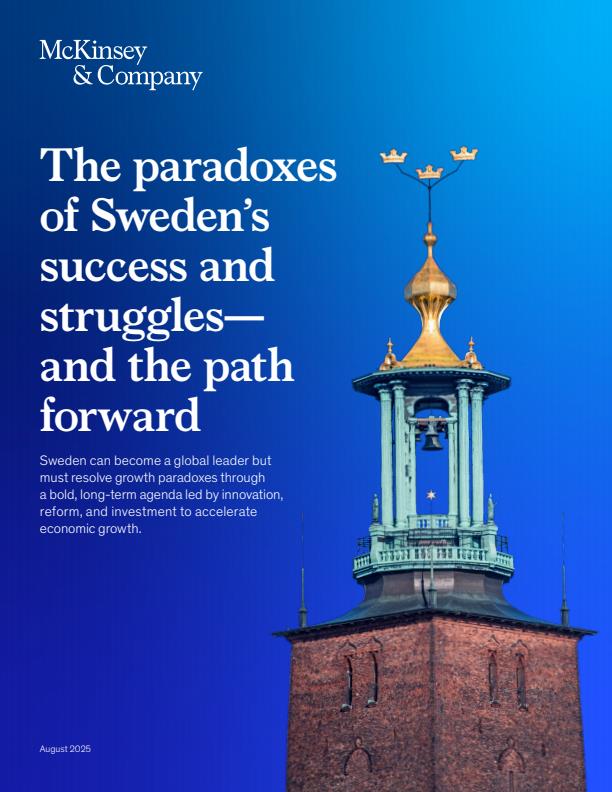A long history of industrial development, a stable welfare state, low public debt levels, and high quality of life: Sweden is globally recognized as a leading nation, and for good reasons. But there is more to the development of the country than these general statements suggest. The debate about Sweden—and its current trajectory—is very active. While the country has indeed experienced a great degree of success, it has also had some recent struggles.
In this report, we first take a longer perspective on the development of the country. We then explore a set of recent paradoxes and global forces that have had, and will continue to have, a fundamental impact on the country. Finally, we present a set of recommendations for Sweden’s future.
We believe Sweden has the potential to become one of the world’s best-performing nations. To achieve that, Sweden needs to act across three broad themes.
First, Sweden needs to establish a long-term vision and direction—broadly shared among employers, trade unions, and civil society actors—that hold over time and create stability and fertile ground for development and investment.
Second, Sweden needs to intentionally increase the pace of economic growth, primarily through productivity improvement. Swedish export-oriented companies’ ability to improve competitiveness, and hence productivity, represents the country’s single largest opportunity for long-term prosperity.
And third, significant reform and investments in infrastructure and human capital are called for to support this development. The needs are well researched and explored, and addressing them is primarily a matter of mobilization and execution at a higher pace than observed currently.
Looking back: A history of economic progress and prosperity
Sweden has performed better than most Western economies over a long period of time. Over the past 30 years, it has outpaced the rest of Europe and stayed almost on par with the United States in terms of real GDP growth (Exhibit 1). This strong performance has been fueled by an innovative, knowledge-based, diversified, and export-led economy; the value of exports compared to GDP is 55 percent, or 70 percent if excluding the public sector. The country’s economic success is thus rooted in its ability to compete internationally, as it has done so successfully over decades. The financial system is efficient, with deep public capital markets and a quickly expanding private capital market, both ranking third in Europe as a proportion of the local economy.

In addition, Sweden has long been considered one of the world’s best places to live, ranking in the top five OECD countries for life expectancy, happiness, health, social mobility, equality, sustainability, and trust.
The seven paradoxes of a recent loss in momentum
Over the past decade, however, Sweden has lost its momentum in economic growth. The country has moved from overperformance to underperformance, with a nearly one-percentage-point negative swing in real GDP per capita growth—which now trails both the US and EU average (Exhibit 2). Had Sweden continued the same growth path over the past decade as during the 20 years prior, an additional 650 billion Swedish kronor (€58.2 billion) in GDP could have been created. That is equivalent to 10 percent of current GDP, covering the entire healthcare budget of Sweden, or more than double the country’s new target of spending 5 percent of GDP on defense.

We have identified seven factors that help explain this underperformance (Exhibit 3). Many of these factors are paradoxical in that they also relate to some of Sweden’s core historical strengths.

- Successful companies and high spend on R&D, but declining pace of productivity improvements. Swedish corporations are five times more prevalent among Europe’s top 1,000 listed companies than would be expected given the relative size of the Swedish population. Swedish companies also spend more on R&D than those in both the United States and the EU when measured in relation to GDP. Despite these strengths, Sweden has experienced a larger decline in productivity growth compared with the United States and EU. The decline is true also for the export-oriented sectors, raising the important question of a potentially diminishing competitiveness of the export-oriented companies in Sweden. In fact, this paradox represents more than half of the identified loss in momentum.
- World-leading entrepreneurship, but struggling to retain companies. Per capita, Sweden produces more unicorns—start-ups with valuations of $1 billion or more—than any other country in Europe. When looking at the creation of so-called decacorns (companies with a value of more than $10 billion), Sweden is responsible for as much as 36 percent of the European total, while accounting for just 3 percent of the European economy. However, more than 70 percent of Sweden’s unicorns, as measured by valuation, leave the country, typically acquired by foreign companies or through listings abroad.
- A globally recognized welfare state, but administrative jobs growing faster than frontline personnel. Sweden’s public system is an often-referenced international benchmark, and Swedes’ own trust in public institutions ranks fourth in Europe. While public sector productivity is difficult to measure, the sector has seen three times higher growth in administration and management staff than in frontline staff in recent years and an increase in public sector hours worked per capita.
- Fast implementer of regulation, but slowing permitting processes. Sweden introduces new regulation more quickly than most European countries, ranking third on this metric among EU countries. But the same efficiency is not seen in permitting processes—lead times have increased 50 to 300 percent in the past ten years for some domestic permitting processes, including those related to energy, the environment, and construction.
- High employment rates, but increasing structural unemployment. Sweden boasts one of the highest employment rates in the OECD and has seen record job creation of more than 640,000 new jobs in the past ten years. However, structural unemployment has increased by 1.5 percentage points in the same period, indicating, among other things, a skills mismatch. Swedes also work around 10 percent fewer hours than the average EU worker and around 20 percent fewer hours than the average US worker.
- High education rates, but lacking graduates in some key strategic areas. Sweden has one of the world’s highest education rates, underpinned by universal university access and high per-student spending. However, the system does not always align with labor market needs. For example, Sweden has fewer STEM graduates than peer countries, limited enrollment in vocational programs, and a limited wage premium from tertiary education.
- History of investments in infrastructure, but rising maintenance debt and increasing future needs. Sweden’s past success has been well served by significant investments in foundational infrastructure, including widespread fiber access and one of the world’s greenest and most affordable electricity systems. However, Sweden’s maintenance debt in road and rail has almost doubled in the past decade, the country is no longer seen as leading in digital infrastructure, and energy-generation capacity needs to expand by more than 60 percent over the next 20 years.
The impact of a new era
Along with the rest of the world, Sweden is entering an era shaped by significant change. In this report, we explore five global forces and their impact on Sweden. In aggregate, we estimate that these forces have the potential to swing Swedish GDP by one trillion Swedish kronor over the next ten years (Exhibit 4). Of these five, the first three will likely have the highest impact over the coming decade. Sweden will need to adapt to these trends and seize the opportunities for the country to stay internationally competitive and to achieve continued economic growth.

- A new form of global competition. Sweden faces growing international competition, which is increasingly taking on new forms. In sector after sector, foreign companies—often Chinese- and, in some instances, US-based—lead not only on lower cost but also on better product performance. As a result, market shares are shifting away from Europe, including from Sweden. Some argue that the shifts in the underlying model are similar to what we experienced with the onset of lean manufacturing in the 1990s, when Asian companies started to lead on quality. Swedish companies must learn from this new form of competition, adapt to it, and innovate to stay internationally competitive.
- An artificial intelligence and automation revolution. The continued rapid introduction of AI and automation represents a major opportunity for Sweden, given the composition of the Swedish economy. Sweden is the fourth most digitalized European country, suggesting a high degree of readiness to capture this opportunity, and the start-up scene has experienced a number of promising developments. However, Sweden currently lags behind peers in broad adoption of AI. The country ranks 25th on the Global AI Index—significantly below many of its peer nations.
- A new geopolitical landscape. In the face of considerable geopolitical uncertainty, trade flows and national security have risen to the top of the agenda for both countries and companies. Sweden’s high export and import dependency—the value of each is in excess of 50 percent of GDP—leaves Sweden more exposed than other countries. How the country collaborates through the EU and independently, and how it manages to secure supply and offset dependency of products and services, can mean a relative advantage or disadvantage compared to other countries. The evolving geopolitical landscape also presents an opportunity for Sweden’s mature defense industry.
- A new take on the green transition. The need to enhance sustainability and transition to a net-zero economy remains an unresolved global challenge, albeit one that has received less attention in recent years. A new narrative is developing in which businesses are expected to deliver shareholder value first and carbon reduction second, if at all. Corporate reporting on the topic has fallen by 34 percent in the United States and 25 percent globally in just three years. That said, Sweden is still a front-runner in the green transition, and low energy prices and near fossil-free electricity provide a platform for excellent opportunities for growth in several sectors. Moreover, Swedish companies have previously demonstrated that it is possible to increase profits while simultaneously reducing carbon emissions.
- An aging population. Shifting age structures, in which fewer people support an increasingly old population, is an increasing problem for the entire Western world. For Sweden, however, the problem may have less impact, at least in the short term. Because of recent immigration, the working-age share of the population is increasing and by 2029 will surpass the average across the rest of the EU. The country’s relatively better age pyramid represents an opportunity for the future.
A path to world-class performance and competitiveness
We believe Sweden has the potential to become one of the world’s best-performing nations. The country has many of the foundations required but needs to forcefully address the paradoxes behind the recent loss in momentum and fully embrace the challenges and opportunities of the new era. In this report, we present our view of the most important six areas to address:
- Establish a long-term vision and direction. In our conversations with CEOs, one of the themes we heard most often was the need for a renewed vision and direction that extends beyond one mandate period and that is broadly shared among employers, trade unions, and civil society actors. Sweden has in the past achieved considerable change and positive development, particularly in times of crisis, but the country evolves far more slowly without the immediate pressure of required action. Considering Sweden’s starting point and recent history, and comparing it with other small high-income countries that have performed well, a forward-leaning vision and direction could be anchored in the following five areas.
- Accelerate innovation execution. Strengthening export-oriented sectors, through innovation and by improving productivity, is Sweden’s single largest opportunity for improved growth and long-term prosperity. Swedish companies must learn from and adapt to the new form of competition, in aggregate roughly double the pace of innovation, and shift R&D spend to faster-growing sectors of the economy to stay internationally competitive.
- Grow high-potential industries. Economic renewal is a hallmark for high-performing countries. Sweden already boasts a leading track record in unicorn creation and has “the right to win” in at least eight of 32 future high-growth sectors. Allocating resources and supporting the development of new businesses will be required. But the conditions for retaining these businesses in the country must also improve.
- Drive output in the public sector. The public sector remains one of the largest areas of the Swedish economy, but it is not showing signs of productivity improvement. For this to change, the sector needs to be steered on output instead of input, frontline personnel needs to grow faster than administrative jobs, and economics of scale need to be captured.
- Increase attractiveness for talent and capital. Talent and capital fuel the economy. While Sweden has many attractive characteristics, trends are going in the wrong direction on some basic features, such as accessibility of housing, crime rates, and education. Sweden should make it easier and more attractive for experts and leading talent to move to Sweden, and the business environment for both talent and capital needs to become more predictable and stable. In addition Sweden needs to help enable access to larger and deeper markets to compete with other leading economies.
- Invest in regulatory reform, infrastructure, and human capital. Periods of high economic growth in Sweden have correlated with effective reform and well-placed infrastructure investments. Many argue that the recent past and the impact of the new era call for another round of more comprehensive reforms implemented at a much higher pace than currently—for example, within regulation and permitting, education and research, labor market flexibility, and AI adoption. Sweden must also address the rising need for investment in transportation, digital infrastructure, and energy.
If Sweden successfully acts on these recommendations, it could see GDP per capita growth of 2.0 to 2.5 percent per annum, significantly above the expectation of 1.6 percent, and climb in GDP per capita rankings versus other Western economies (Exhibit 5). More importantly, this level of growth would enable Sweden to invest in its future, meet its obligations to current and future generations, and secure its long-term prosperity.



